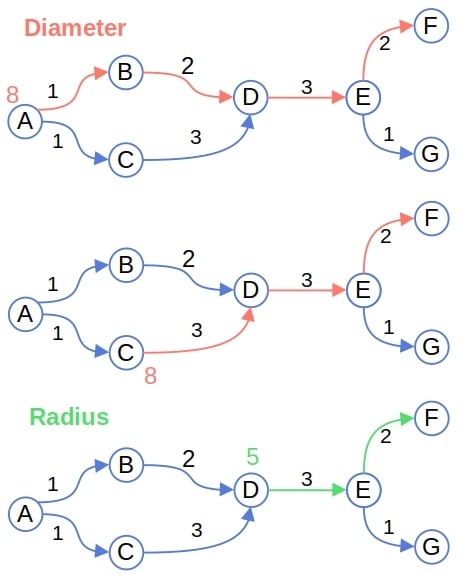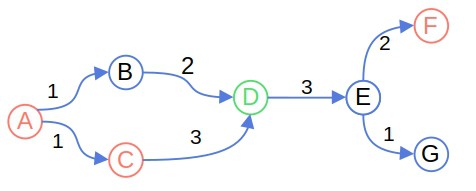1. 概述
在本篇文章中,我们将介绍图论中的五个核心概念:偏心距(eccentricity)、半径(radius)、直径(diameter)、中心(center) 和 边缘(periphery)。
这些指标广泛应用于图分析中,尤其在城市规划、社交网络分析、交通网络优化等领域。它们帮助我们理解图的结构特性,并为节点定位提供量化依据。
为了定义这些概念,我们首先需要了解图中“最短路径”的定义,因为这些指标都依赖于节点之间的最短路径长度。
2. 图与距离
我们考虑一个带权图 ,其中:
是节点集合
是边集合
是边的权重(或长度)
我们定义两个节点 之间的最短路径长度为
,这是一个距离度量。
这个度量满足三角不等式:
$$ d(u, v) + d(v, w) \leq d(u, w), \quad \forall u, v, w \in V $$

这是因为 是从
到
的最短路径长度,所以任何其他路径都不会更短。
3. 偏心距(Eccentricity)
一个节点的偏心距定义为它到图中所有其他节点的最短路径中的最大值:
$$ e(u) = \max { d(u, v) \mid v \in V } $$
例如,下图中节点 A 的偏心距是 8,对应路径为:
$$ A \rightarrow B \rightarrow D \rightarrow E \rightarrow F $$

4. 半径与直径(Radius and Diameter)
4.1 直径(Diameter)
图的直径是所有节点偏心距中的最大值:
$$ \text{diameter}(G) = \max { e(u) \mid u \in V} $$
4.2 半径(Radius)
图的半径是所有节点偏心距中的最小值:
$$ \text{radius}(G) = \min { e(u) \mid u \in V } $$
⚠️ 注意:这两个术语在不同上下文中有不同含义。例如,在某些情况下,直径也可能指图中最长的路径。
以我们之前的图为例:
- 直径是 8,由节点 A 和 F 之间的路径构成
- 半径是 5,由节点 D 和 F 之间的路径构成

4.3 半径与直径的关系
我们可以证明:
$$ \text{diameter}(G) \leq 2 \times \text{radius}(G) $$
这个不等式可以通过三角不等式推导得出。设 和
是图中距离最远的两个节点(即直径路径的两端),再设
是中心节点,根据三角不等式:
$$ d(u, w) \leq d(u, v) + d(v, w) $$
由于 是中心节点,其偏心距等于半径,因此:
$$ d(u, v), d(v, w) \leq \text{radius}(G) $$
从而:
$$ \text{diameter}(G) \leq 2 \times \text{radius}(G) $$
5. 中心与边缘(Center and Periphery)
5.1 中心(Center)
图的中心由所有偏心距等于半径的节点组成:
$$ \text{center}(G) = { u \in V \mid e(u) = \text{radius}(G) } $$
5.2 边缘(Periphery)
边缘节点是指偏心距等于图的直径的节点:
$$ \text{periphery}(G) = { u \in V \mid e(u) = \text{diameter}(G) } $$
以我们之前的图为例:
- 边缘节点是 A、C 和 F
- 中心节点是 D

✅ 中心节点通常用于部署设施(如医院、仓库),因为它们可以最小化最远距离
✅ 边缘节点适合部署需要彼此距离最远的对象(如变电站、通信基站)
6. 总结
我们介绍了图论中五个重要概念:
- 偏心距:节点到其他节点最远距离
- 直径:图中所有节点偏心距的最大值
- 半径:图中所有节点偏心距的最小值
- 中心:偏心距等于半径的节点集合
- 边缘:偏心距等于直径的节点集合
这些指标帮助我们理解图的结构,也常用于实际场景中的最优节点选择。
✅ 半径与直径之间存在确定的关系:直径 ≤ 2 × 半径
✅ 中心节点是图中最“平衡”的位置,适合部署关键设施
✅ 边缘节点则适合部署需要最大化距离的设施
这些概念虽然基础,但在网络分析中非常实用,建议在实际项目中尝试应用。